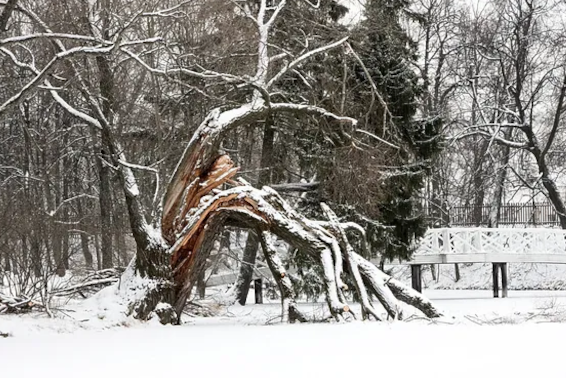
Winter brings lights, cheer, good will and … snow-damaged tree limbs. When you live in an area with heavy snowfall, your trees might become a victim the next time the forecast says snow. What should you do when the storm lets up and your trees’ branches are broken and bent? Should you stand pat or take action? We can help clear up any misconceptions on how to respond to snow-damaged tree limbs.
Assess Trees for Weaknesses Before Winter
First things first: The best way to help your trees is to shore up their weaknesses before the snow starts. When trees have areas of decay, an imbalanced root system, dead branches or their branches have a large lateral surface area, they are more susceptible to snow and ice damage. If you aren’t sure if your trees need care, contact a certified arborist for an in-depth tree inspection. They will help you determine if any pruning or fortification is in order for trees to make it through the winter unharmed.
Feed Trees Before Dormancy
If the area you live in is prone to specific nutrient deficiencies, it can be beneficial to apply fertilizer within the dripline before dormancy sets in. Also, water within the dripline, then cover the area with thick, insulating mulch. This will help the tree’s roots retain moisture and sustain warmth throughout the upcoming winter.
Make Safety Your First Priority
When you have a downed tree limb or a branch that looks like it’s about to collapse from the weight of snow, be extremely careful. Stay away from the tree if the trunk is cracked or damaged. Call your utility company if there are any downed power lines nearby or touching the tree. As much as you care about your trees and want to help them thrive, your safety comes first.
Don’t Remove Snow — with One Exception
In general, you shouldn’t try to remove snow and ice from tree branches. This usually causes more harm than good. However, there is one exception: light, fluffy snow. If you can easily sweep it off with a broom, it’s OK to do so with care. Ask an Arborist How to Prune Damaged Limbs When branches are damaged and sections are broken, it’s vital to trim the ragged edges left behind. If you don’t, you’re leaving the tree open to disease and infestation. With sharp tools, make clean cuts to remove snow-damaged tree limbs, as long as they are small enough to handle with pruning shears. In general, leave more complex cases to certified arborists who have the equipment and the know-how to resolve the issue in a way that is best for your tree. There is an art and a science to tree pruning, and you should never opt for DIY if you don’t have an in-depth knowledge of the right practices.
Care Should Continue into Spring
Trees that sustain a significant amount of damage in the winter may benefit from a specialized care program in the spring involving extra fertilizer and water. Again, your arborist will have the best advice based on the type of tree and the extent of the damage. Dealing with snow-damaged tree limbs isn’t always straightforward or easy, but Rivendell Tree Experts is here to help. Call today or whenever you need service or have a question!



